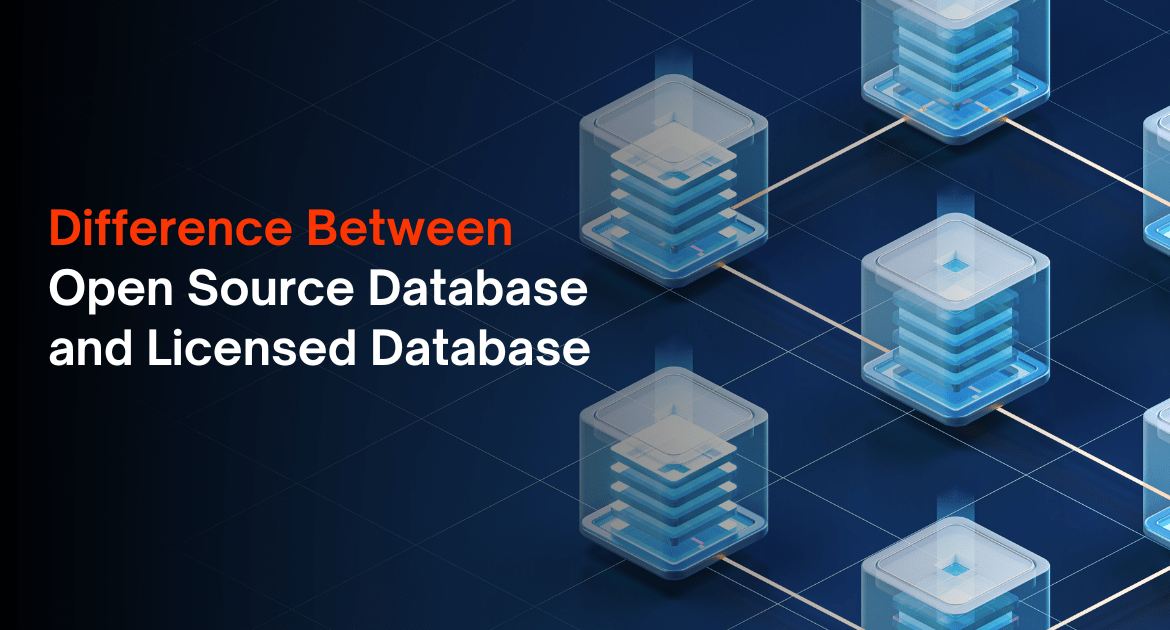In the realm of information technology, databases are crucial for storing, managing, and retrieving data. Databases come in two primary categories: Open Source Database and Licensed Database. This document aims to provide a comprehensive comparison between these two types of databases, covering their features, advantages, disadvantages, and the scenarios in which one might be preferred over the other.
What is an Open Source Database?
An Open Source Database is a type of database management system (DBMS) whose source code is publicly available. This means that anyone can view, modify, and distribute the source code. The community version of these databases is typically free to download and use, although some features or services may incur minimal, affordable costs. The installation and updates of Open Source Databases are managed by the users themselves. Prominent examples of Open Source Databases include MySQL, PostgreSQL, and MongoDB.
Advantages of Open Source Databases
- Cost: One of the primary benefits of Open Source Databases is that they are usually free. This makes them an attractive option for organizations with limited budgets, as there are no licensing fees involved.
- Customization: Since the source code is open, developers can modify the database to meet specific requirements. This level of customization is beneficial for organizations with unique needs that cannot be met by out-of-the-box solutions.
- Community Support: Open Source Databases have large, active communities that contribute to the development, documentation, and improvement of the software. This community-driven support can be invaluable for troubleshooting and finding solutions to common issues.
- Security: The open nature of these databases allows for greater transparency. Security vulnerabilities can be quickly identified and patched by the community, ensuring a higher level of security.
- Scalability: Open Source Databases are designed to scale efficiently, making them capable of handling large volumes of data and high traffic loads. This scalability is crucial for growing businesses and applications.
Disadvantages of Open Source Databases
- Limited Technical Support: While community support is available, it may not always be sufficient for complex issues. Professional technical support is often not guaranteed, which can be a drawback for businesses that require reliable assistance.
- Complexity: Setting up and configuring Open Source Databases can be challenging, especially for users without extensive experience in database administration. This complexity can result in longer deployment times and higher initial setup costs.
- Lack of Features: Open Source Databases may not include all the advanced features found in Licensed Databases. For instance, features like advanced analytics, reporting tools, and data visualization may be lacking, which could limit their utility for certain applications.
What is a Licensed Database?
A Licensed Database is a commercial database system that requires the purchase of a license for use. These databases are typically developed by commercial vendors and come with a guarantee of professional technical support. The installation and updates are managed by the software vendor, ensuring that the database remains up-to-date and secure. Examples of Licensed Databases include Oracle, IBM DB2, and Microsoft SQL Server.
Advantages of Licensed Databases
- Technical Support: Licensed Databases usually come with professional technical support. This support can be crucial for organizations that need help with setup, configuration, or troubleshooting.
- Features: Licensed Databases often offer a wide range of advanced features that are not available in Open Source Databases. These features can include advanced analytics, reporting, data visualization tools, and more.
- Security: Licensed Databases typically have robust built-in security features. These features provide better protection against cyber threats, making them a preferred choice for organizations that handle sensitive data.
- Integration: Licensed Databases are often designed to integrate seamlessly with other enterprise software. This makes it easier for organizations to incorporate the database into their existing IT infrastructure.
Disadvantages of Licensed Databases
- Cost: Licensed Databases can be expensive. The costs include not only the initial licensing fees but also ongoing maintenance and support costs. This can make them less accessible for smaller organizations or startups.
- Vendor Lock-In: Organizations that use Licensed Databases may become dependent on the vendor. This dependency can make it difficult to switch to another database system in the future, leading to potential vendor lock-in.
- Limited Customization: Licensed Databases may not offer the same level of customization as Open Source Databases. This limitation can be a disadvantage for organizations with specific requirements that cannot be met by the out-of-the-box features of the database.
Similarities Between Open Source Database and Licensed Database
Despite their differences, Open Source Database and Licensed Database share several common characteristics:
- Data Handling: Both types of databases are capable of handling large amounts of data and supporting complex data structures.
- Data Storage and Retrieval: Both can be used to store and retrieve data in a structured manner, using SQL (Structured Query Language) for queries and data manipulation.
- Support for Mission-Critical Applications: Both types of databases can support mission-critical applications and services, providing the reliability and performance needed for essential business functions.
- Remote Access and Management: Both Open Source and Licensed Databases can be accessed and managed remotely using a variety of tools and interfaces.
- Optimization: Both types of databases can be optimized for performance, scalability, and security, ensuring that they meet the needs of the organization.
Detailed Comparison of Open Source Database and Licensed Database
The following table provides a detailed comparison between Open Source Database and Licensed Database across various aspects:
| Sr. No. | Basis of Comparison | Open Source Database | Licensed Database |
|---|---|---|---|
| 1. | Focus | Source code is open for anyone to view | Created for licensed use only |
| 2. | Examples | MySQL, PostgreSQL, MongoDB | Oracle, DB2, Splunk |
| 3. | Cost | Free or minimal cost | Premium, not free |
| 4. | Community | Code can be shared and modified by the community | Code is not accessible or modifiable |
| 5. | Source Code | Open, with risks of coding issues | Not accessible, high protection |
| 6. | Technical Support | Limited support from community | Guaranteed professional support |
| 7. | License | Free licensing | High licensing cost |
| 8. | Support | Relies on community support | Dedicated vendor support |
| 9. | Installation and Updates | Managed by the user | Managed by the vendor |
| 10. | Benefits | Quick bug fixes, free alternatives, visible for security inspections | Single contact for issues, clear licensing, planned updates |
| 11. | Drawbacks | Volunteer support, compatibility issues, security risks | Strict licensing, costly premium features |
Case Studies and Use Scenarios
To further understand the practical implications of choosing between Open Source Database and Licensed Database, let’s consider some real-world scenarios:
Scenario 1: Small Startup
A small startup with limited financial resources needs a database system to support its web application. The startup chooses an Open Source Database like MySQL because:
- Cost: The startup can avoid high licensing fees.
- Customization: Developers can modify the database to fit the specific needs of the application.
- Community Support: The startup relies on the active community for troubleshooting and support.
Scenario 2: Large Enterprise
A large enterprise with a significant IT budget requires a robust database system to manage its complex data needs. The enterprise opts for a Licensed Database like Oracle because:
- Technical Support: The enterprise needs guaranteed professional support to ensure smooth operations.
- Advanced Features: The enterprise requires advanced analytics and reporting tools that are available in Licensed Databases.
- Security: The enterprise handles sensitive data and needs the enhanced security features provided by the Licensed Database.
Scenario 3: Educational Institution
An educational institution wants to set up a database for its student management system. It chooses an Open Source Database like PostgreSQL because:
- Cost: The institution can use the database without incurring high costs, freeing up budget for other educational resources.
- Scalability: The database can scale to handle the growing number of students and data records over time.
- Community Support: The institution benefits from the extensive documentation and community-driven improvements.
Scenario 4: Financial Institution
A financial institution requires a highly secure and reliable database system to manage its transactions and customer data. It selects a Licensed Database like IBM Db2 because:
- Security: The database provides robust security features that protect against cyber threats.
- Technical Support: The institution requires guaranteed professional support to maintain its critical operations.
- Integration: The database integrates seamlessly with the institution’s existing enterprise software.
Future Trends and Considerations
As technology continues to evolve, both Open Source Database and Licensed Database are likely to see significant advancements. Here are some trends and considerations for the future:
Open Source Database Trends
- Increased Adoption: As more organizations recognize the benefits of cost savings and customization, the adoption of Open Source Databases is expected to grow.
- Enhanced Features: Open Source Databases are continually improving, with communities adding new features and functionalities to meet the demands of modern applications.
- Cloud Integration: The integration of Open Source Databases with cloud platforms is becoming more common, offering scalable and flexible database solutions.
Licensed Database Trends
- Advanced Analytics: Licensed Databases are likely to continue enhancing their advanced analytics and reporting capabilities, providing more powerful tools for data analysis.
- Artificial Intelligence and Machine Learning: Integration with AI and ML technologies will enable Licensed Databases to offer more intelligent data processing and insights.
- Security Enhancements: As cyber threats evolve, Licensed Databases will continue to strengthen their security features to protect against new vulnerabilities.
Considerations for Choosing a Database
When choosing between an Open Source Database and a Licensed Database, organizations should consider the following factors:
- Budget: Evaluate the total cost of ownership, including licensing fees, maintenance, and support costs.
- Technical Requirements: Assess the specific features and capabilities needed to support the organization’s applications and operations.
- Support Needs: Determine the level of technical support required and whether the organization can rely on community support or needs professional assistance.
- Scalability: Consider the future growth of the organization and whether the database can scale to meet increasing demands.
- Security: Evaluate the security requirements, especially if the organization handles sensitive or regulated data.
Conclusion
In conclusion, both Open Source Database and Licensed Database have their own unique advantages and disadvantages. Open Source Databases offer cost-effective, customizable solutions with strong community support, making them ideal for smaller organizations or those with limited budgets. On the other hand, Licensed Databases provide advanced features, robust security, and guaranteed professional support, making them suitable for larger enterprises and organizations with complex data needs.
The decision between an Open Source Database and Licensed Database should be based on the specific needs and resources of the organization. By carefully considering factors such as cost, technical requirements, support needs, scalability, and security, organizations can make an informed choice that aligns with their goals and ensures the successful management of their data.
Ultimately, both types of databases play a critical role in the modern IT landscape, and understanding their differences and use cases can help organizations leverage the best database solution for their needs.




